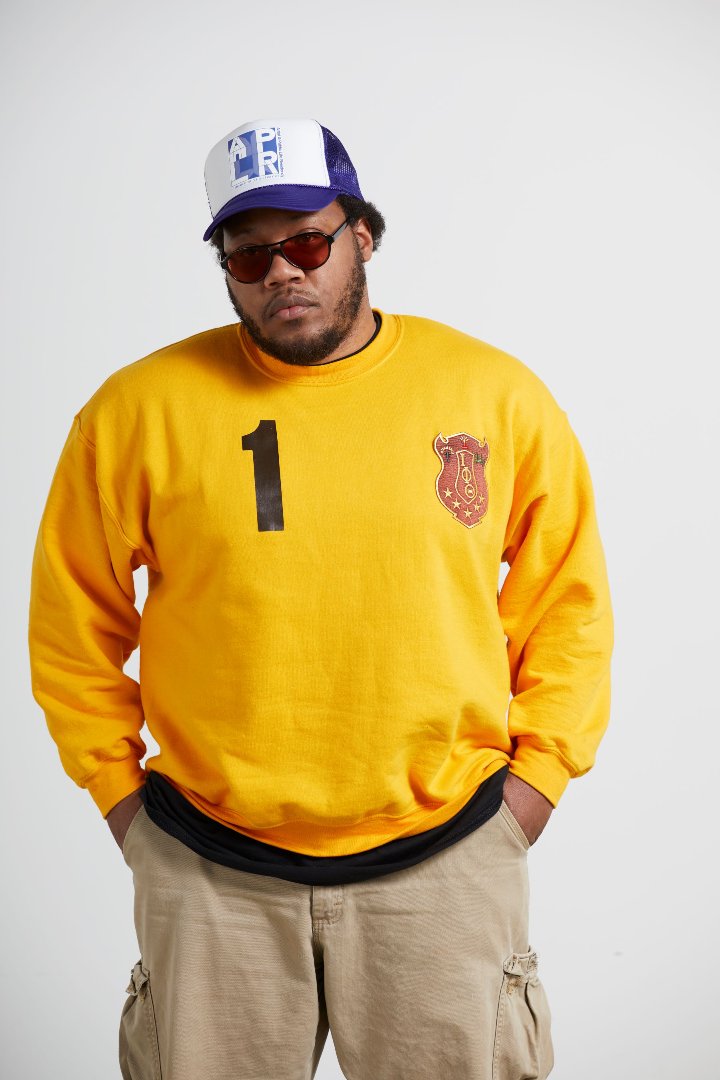Dr. Jarrod Dortch: Local Legend
Dr. Jarrod Dortch wears a lot of hats. I was first introduced to him and his work through We. The Culture Works by The Eighteen Art Collective that is currently on view in the Indianapolis Museum of Art. So, it took me by surprise to learn that “artist” isn’t the first among the hats that he wears.
It turns out, Dr. Dortch’s first significant art experience was when he applied to be a part of the Black Lives Matter Mural on Indiana Avenue in August 2020. A community-builder by education and passion, he was compelled to apply. Fortunately, Mali Jeffers, of GANGGANG, who organized the mural was a classmate of his at Ball State University. He ended up painting the # symbol on the mural, in what I now know is true Dr. Dortch fashion, he used the process as an opportunity to connect and heal.
I sat down with Dr. Dortch on a rainy Friday before Dr. Martin Luther King Jr. Day to talk about his passions, legacy, and how he uses his talent to build a better community than the one he came from.

Taylor Hurt (TH): What made you reach out to Mali?
Jarrod Dorch (JD): We were in quarantine, and I needed to do something (without fighting or crying) with all the hurt and anger that I was experiencing following the murder of George Floyd. The mural was less about art for me and more about making an impact and creating an opportunity for catharsis.
TH: Your approach to designing your letter, or symbol in your case, stands out. Can you talk about that?
JD: A friend from high school asked if her brother could participate and when we started working people who’d gathered that day asked if they could help too. Since the hashtag was at the beginning of the mural, we wanted it to symbolize the painful beginnings of Black people in America, that’s why we chose to depict slaves crying blood. I also had everyone who participated in the process write out how they were feeling so that we could begin to purge and heal.
TH: How do you combine your talent for creating with community building to make a difference?
JD: I curate. Recently I curated Art and Vinyl at Big Car and AUX at Hoy Polloy. There are a lot of artists of color in the city that have been doing work for decades who I respect, love, and appreciate. I want to develop opportunities for them and the next generation coming up after us.
TH: You grow food as well, right?
JD: And I take care of my elderly parents. But yes, I own a business called Solful Gardens. I started gardening as a form of therapy while I was writing my dissertation, and over time it expanded into a business. These days I mainly use Instagram and Facebook to sell raised garden beds that I build.
TH: You care deeply for your community; would you call yourself an activist?
JD: No. I don’t feel like I’m advocating for anything in particular, I just want better for the people that I love. If I need to grow food for people, I will. If I need to teach a class, I will. If I need to work on the Black Lives Matter mural, I will. To me, caring for each other is just what you’re supposed to do.
TH: How does being a caregiver impact you being a community leader and vice versa?
JD: The more that I pour into this city the better overall it will be for everyone. My family, my friends, and the people that I care about are an extension of Indianapolis, so it’s my responsibility to make sure that my city and my people are established, whole, and esteemed.
TH: I know your brother who died when you were 18 was an artist, do you feel like you’re living his dream?
JD: When he passed, I felt the need to be two sons for my parents. I have a doctorate, I own a business, I’m an active community member of my own volition; but I’ve also achieved some of my brother"s dreams. Even when I got my start in community art, it was with the intention of furthering his legacy.
TH: If your brother could see you now, what would he say?
JD: You’re doing good, but you could be doing more. And those lines aren’t straight, use a ruler next time. Not in a bad way, in a brotherly way.
TH: That’s a lot of pressure.
JD: But the belief is that I can do anything. And I worry about how much time I have left. I don’t want children so my legacy will be what I leave behind and I want to accomplish as much as I can.
TH: So, then what do you hope to accomplish?
JD: I would like people to say Jarrod did whatever he could do to benefit the people he loved and left behind. If the next person who wants to uplift others can achieve more because of the things that I’m doing now, that’s my legacy.
Catch Dr. Dortch’s pieces DENKYEM, AKOMA, DUAFE, NKYINKYIM in We. The Culture Works by The Eighteen Art Collective on display in the Indianapolis Museum of Art at Newfields through September 24, 2023.
You can connect with Dr. Dortch by following his personal Instagram @jarroddortch, his business @solfulgardens, or his community work and poetry at @i.am.flamo.
Exhibition Credit:
We. The Culture: Works by The Eighteen Art Collective is presented by Aaron Wealth Advisors, Gary & Hannah Hirschberg. Lead support is provided by Rachel M. Simon & the Herbert Simon Family Foundation and June McCormack. Associate support is provided by IceMiller and its Racial Equity Solutions Team. Additional support is provided by Judy Donner, Nathan & Deborah Oatts, and Emily A. West.




